- Home
- Encyclopedia
- Holding On To Sovereignty: The Tribes Mix Old F...
Holding on to Sovereignty: The Tribes Mix Old Forms with New
In the early decades of the 20th century, Eastern Shoshone and Northern Arapaho people in Wyoming found new ways to keep old traditions alive. At the same time they settled an old dispute by means of a long lawsuit, while always negotiating and re-negotiating their evolving relationship with the U.S. government.
The treaty the Arapaho had signed in 1868 promised them a reservation of their own, but with no place specified for it; after ten years on the move, the Arapaho were escorted to the Shoshone Reservation by the U.S. Army under an arrangement everyone had assumed to be temporary. The two tribal nations had been in open warfare just four years prior to that, and bad feelings lingered between them.
As decades passed, the Shoshone quite likely continued to resent Arapaho presence on the reservation. For their part, the Arapaho were uncertain about whether and to what extent they could count on the U.S. government to support their presence on Wind River.
By the turn of the last century, the notion that American Indians were a “vanishing race” was widespread in white America. Tribal people’s best hope of survival, the notion ran, was assimilation—becoming more like white people and abandoning Indian ways. And that included adopting white people’s forms of government.
In 1896, for $60,000 in cash and cattle, the tribes sold 64,000 acres of land around the Big Horn Hot Springs at the northeast corner of the Shoshone Reservation, as the reservation on Wind River was still called. In 1905, the tribes gave up 1.5 million more acres—the rest of the reservation land north of the Big Wind River—for a complicated series of present and future payments.
Officials in the U.S. Indian Bureau, the predecessor of today’s Bureau of Indian Affairs, steadily pushed all tribes to move away from their consensus-based traditions of leadership toward forms of majority-rule, representative government more like ones white people used.
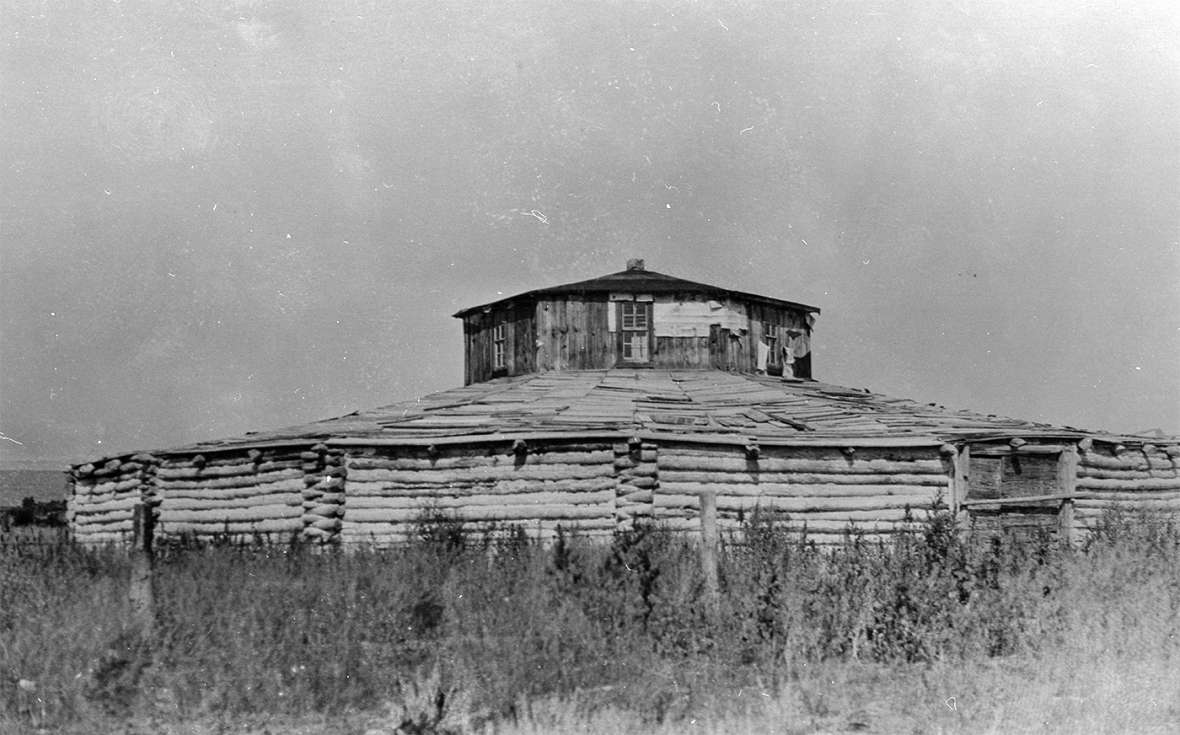
Changes in tribal government
In the first years of the 20th century, Indian Bureau superintendents appointed councils of six men from each tribe to conduct tribal business and act as liaisons with the bureau—a transition from older leadership traditions of chiefs and sub-chiefs. In subsequent decades, the bureau pressed for establishment of a joint business council, with six elected members from each tribe. Both tribes complied, and the joint business council then met regularly to deal with matters affecting both tribes.
Both tribes also resisted, however, the idea of representative government. They left ultimate sovereignty and authority with their general tribal councils, composed of all members of the tribe.
In the 1920s and early 1930s, Shoshone Agency Superintendent Ruben Haas worked hard to persuade the two tribes to adopt individual constitutions and bylaws based on United States representative forms of government. These systems would have given more power to the business councils, allowing them to proceed without input from the general councils. Haas tried in 1925, 1931 and 1934, each time presenting a draft constitution with more radical changes than the preceding one. The proposals also included moves toward more independence from the Indian Bureau. In the end, all three drafts failed to win approval from either the bureau or the tribes.
In 1934, a reform-minded U.S. Congress, during the second year of President Franklin D. Roosevelt’s New Deal, passed the Indian Reorganization Act. The new law aimed at more autonomy and self-determination for all tribes in the nation. The law called for Indian lands and resources to be better preserved, established a credit system and vocational education for Indian people and provided for tribes to incorporate and form businesses.
Tribal lands were no longer to be allotted to individuals, as had been happening piecemeal since Congress passed the Dawes Act in 1887. Instead, all reservation lands would be held in trust by the government. All tribal constitutions required approval by the U.S. Department of Interior and its Indian Bureau. The new law allowed the tribes a year to choose by majority vote whether to accept these changes.
At that time, according to Shoshone historian John Washakie, the general councils of both tribes approved a proposal to divide the reservation in half along a north-south line running just west of Ethete. The area to the east and downstream would be a Northern Arapaho reservation. The area to the west would be an Eastern Shoshone reservation. But the Bureau of Indian Affairs denied the possibility, because its officials realized the Arapaho still had no legal status, Washakie says.[1]
Nationwide, 258 different tribes voted on the reorganization option. Of those, 181 voted to accept. Both tribes on Wind River were among the 77 tribes that rejected the changes, however. At least in part, according to historian Janet Flynn, their vote reflected a deep distrust of the U.S. government and its Indian Bureau.
Virtually all treaties and agreements with both tribes had been broken one way or another, the tribal members felt, and they were especially skeptical of placing large sums of tribal money in trust with the government, according to Flynn. Also, the so-called self-determination offered by the government did not seem genuine if every detail of any new tribal structure would require bureau approval.[2]
Given what had happened in the past, members of the Arapaho and Shoshone tribes must have seen little reason to trust the U.S. government to keep its promises in the future.
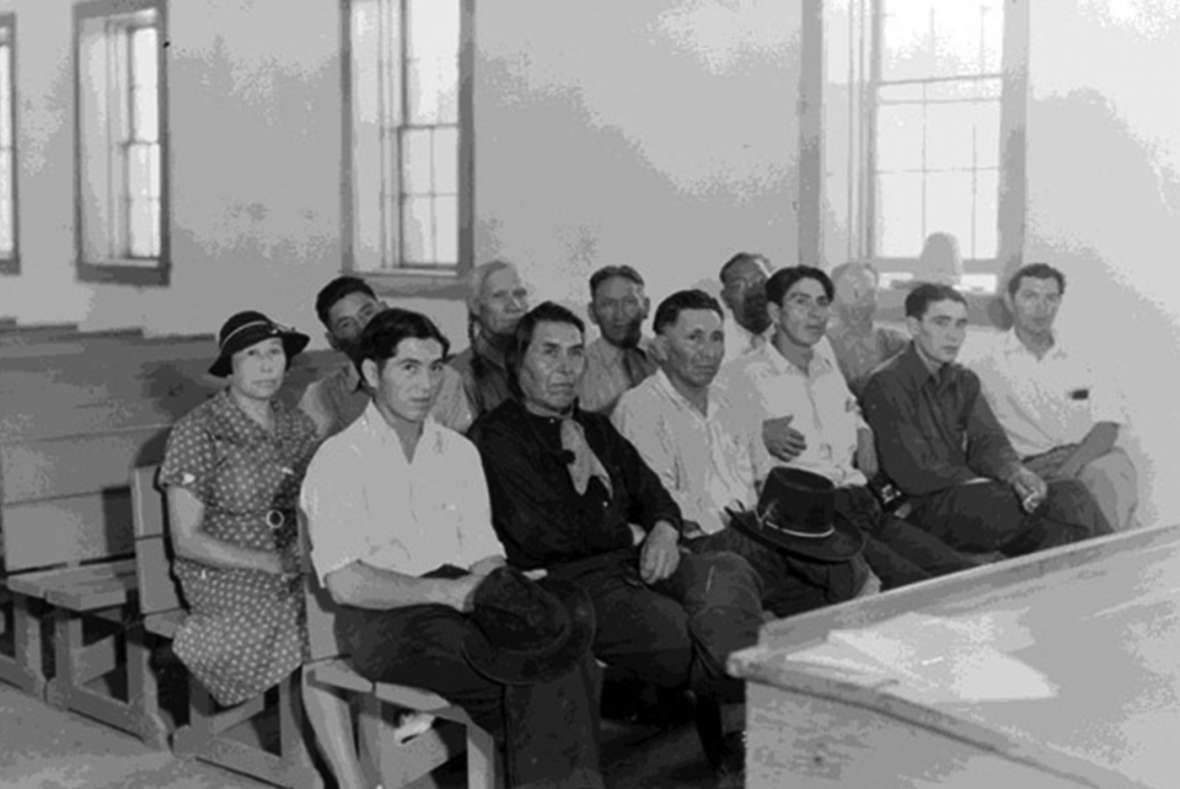
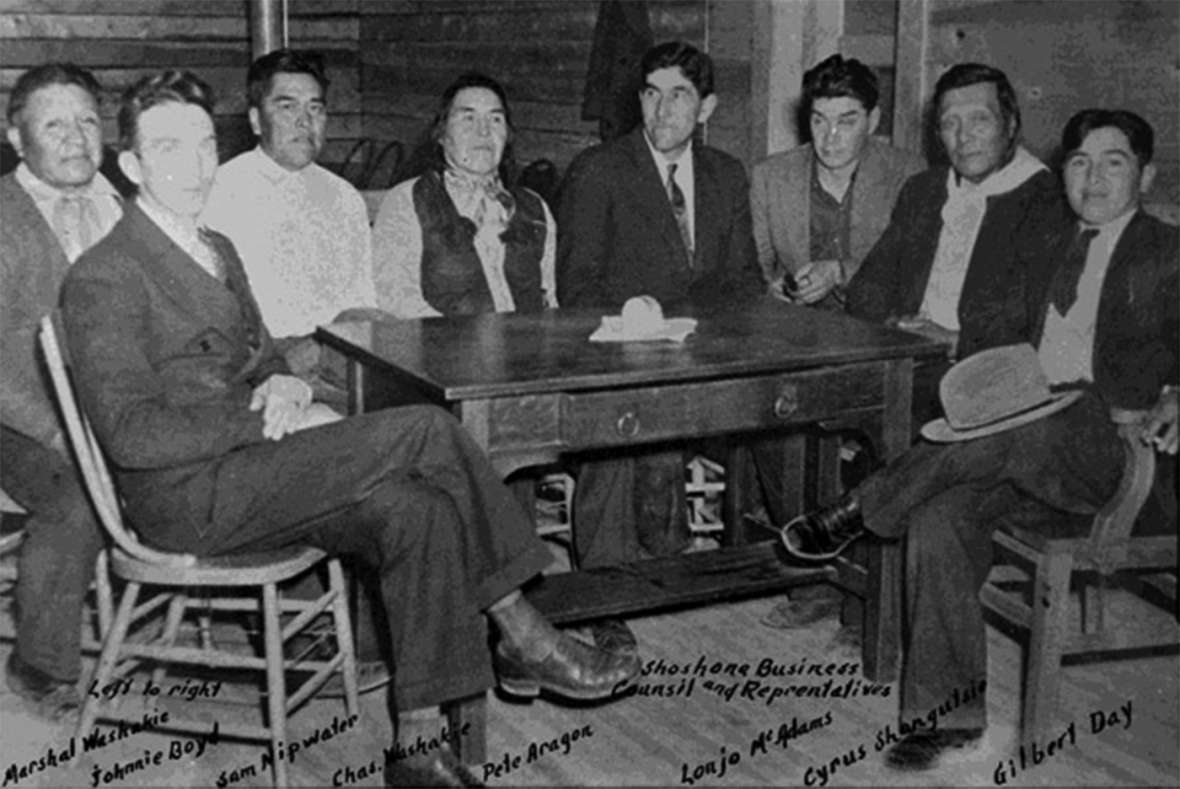
The Tunison lawsuit and settlement
Also during these years, the question of the legality of the Northern Arapaho presence on the Shoshone Reservation at Wind River finally came to a head.
In 1928, Congress passed a law allowing the Eastern Shoshone Tribe to sue the U.S. government for violating provisions of the The Fort Bridger Treaty of 1868, under which the Eastern Shoshone bands had given up a reservation of more than 44 million acres for exclusive rights to a 3-million-acre reservation on Wind River.
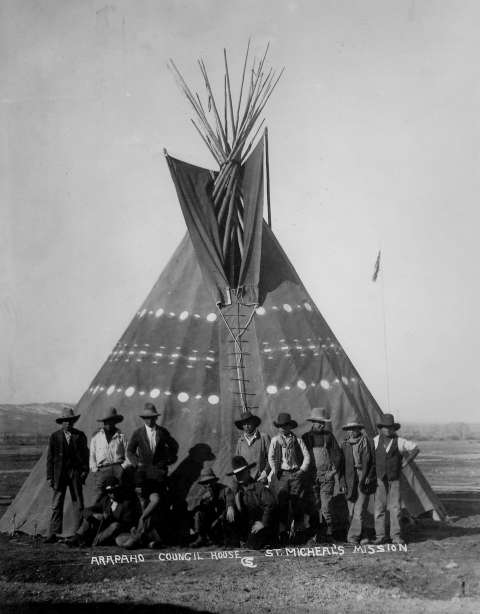
George Tunison, attorney for the tribe, argued that without Shoshone approval, the Indian Bureau had allowed the Arapaho to settle permanently at the Shoshone Agency in 1878. From that point on, the government treated both tribes—unofficially and, the Shoshones argued, illegally—as equal beneficiaries of resources, with Arapahos sharing in Shoshone payments from the land cessions of 1896 and 1905, and taking up individual land allotments under the Dawes-Act system.
The case took years to move through federal courts. In 1937, the U.S. Supreme Court finally ruled in the Shoshones’ favor. Arapaho people, historian Loretta Fowler writes, were relieved. “They had long smarted under Shoshone accusations of trespass.” Now, they could no longer be seen as intruders. Their presence on the reservation was affirmed by the court—and the Shoshones would be compensated for having shared their reservation for six decades.
As part of the settlement, the Shoshone now had to recognize the Arapaho right to live on Wind River. And the name of the reservation was officially changed to the Wind River Agency.
Congress approved details of the settlement in a separate law passed July 27, 1939, which included the following provisions:
- After attorney fees were taken out and some funds added in for accrued interest, the Shoshone Tribe would receive about $4.2 million in compensation for 61 years of Arapaho presence on Wind River—nearly $75 million in 2019 dollars.
- Of the $4.2 million, $1 million would be set aside to buy back land within reservation boundaries.
- Each member of the Shoshone Tribe would receive $2,450. Of that amount, $100 would be paid in cash, and $1,350 would be available as credit toward buying land, housing, seed, livestock or support for the old and infirm. In addition, $1000 would go into an account kept for each Shoshone member, to be spent for purposes approved by the secretary of the U.S. Department of the Interior, which in practice meant the Indian Bureau, today’s Bureau of Indian Affairs.
- $125,000 would be placed in a fund that would be used to provide loans to tribal members.
- The remainder would be placed in a capital reserve fund to be spent on projects or other purposes with the approval of the secretary of the Interior.[3]
For some Shoshone families, at least, the settlement payments changed their lives. Many years later, Angie Wagon remembered her parents’ purchase of their first house in 1942 with money from the Tunison settlement. But the payments were always mixed with a sense of being patronized by the U.S. government:
When we got the Tunison money, I never saw so many things. You bought a new bedroom set, your dressers all were marked “G.I.” [Government Issue] on the bottom. Everything was government issue and they had pencils and they marked your pencils “G.I.” You had horses running around with your brand on them and an “ID” [Indian Department] on the bottom. I always thought that was funny. I said “Why do you need two brands?” And Dad said, “Well, that’s so you won’t take that horse and sell him, you know.”
And I guess it was just to keep people—I said they treated us like we were babies. I’d sit and think about things like that and I thought that was so unnecessary for people to treat you like you couldn’t count money and you don’t know how to spend money…but I think if you come from a large family, a poor family you learn how to save and you care about how your money is spent.[4]
As for the Arapaho, it would be 25 more years before they were compensated with cash for the loss of vast lands they had been guaranteed by the Fort Laramie Treaty of 1851. Both tribes managed to survive congressional efforts in the 1950s to do away with reservations and tribal identities altogether. And not until the 1990s would there be a compromise settlement of water-rights questions on Wind River. The 20th century, that is, would see long years of difficult negotiations among the two tribes, the state of Wyoming and the U.S. government. Gradually, however, some aspects of tribal sovereignty would be regained.
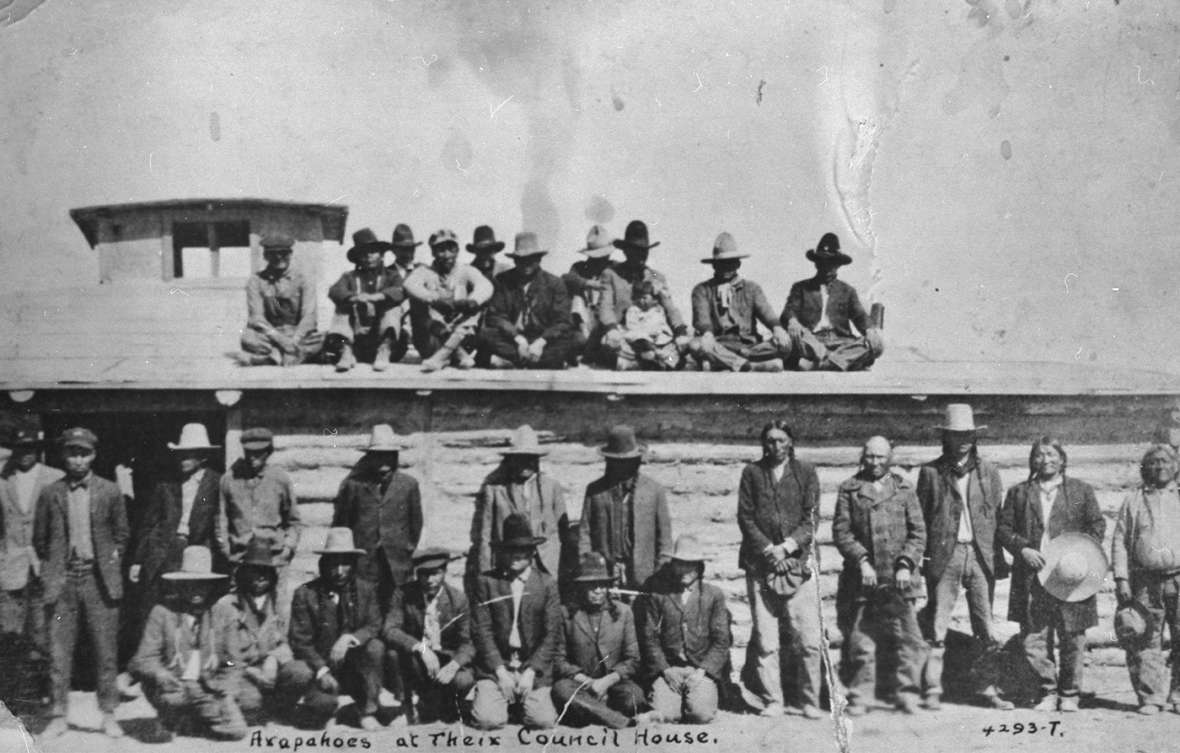
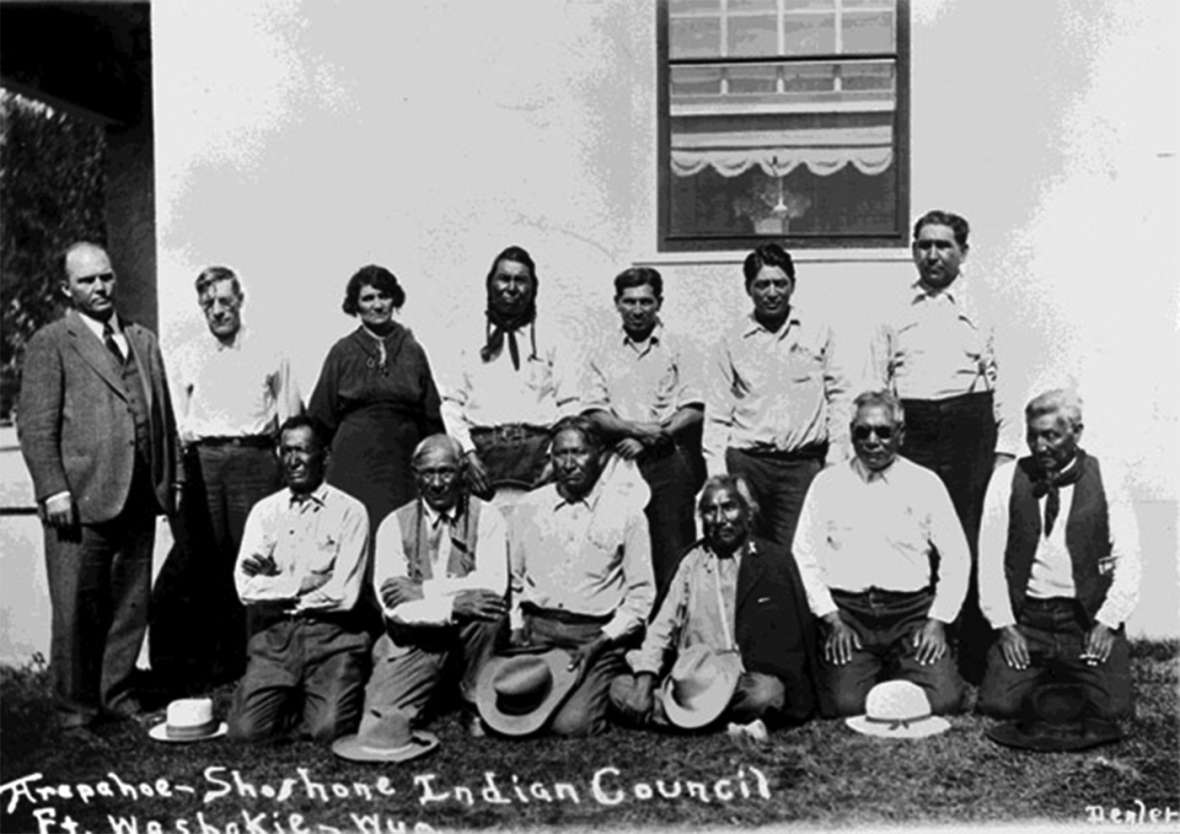
Editors’ Note: This and other 2018 and 2019 articles and digital toolkits on the history of tribal people in Wyoming are possible with support from the Wyoming Cultural Trust Fund, the Wyoming Council for the Humanities and several Wyoming school districts, including districts headquartered in Fort Washakie, Arapahoe, Shoshoni, Lander, Powell, Laramie, Douglas and Afton, Wyoming. WyoHistory.org extends its thanks to all.
Resources
Sources
- “The Arapaho Arrive: Two Nations on One Reservation.” WyoHistory.org, June 23, 2018. Accessed Jan. 22, 2019, at /encyclopedia/arapaho-arrive-two-nations-one-reservation.
- “Coming to Wind River: The Eastern Shoshone Treaties of 1863 and 1868.” WyoHistory.org, May 23, 2018. Accessed Jan. 30, 2019 at /encyclopedia/coming-wind-river-eastern-shoshone-treaties-1863-and-1868.
- Flynn, Janet. Tribal Government: Wind River Reservation. 1991. Reprint, Lander, Wyo.: Mortimore Publishing, 2008. An extremely useful look at the history of government and leadership on the Wind River Reservation, with clear details on the treaties, agreements and lawsuits.
- Fowler, Loretta. Arapaho Politics, 1851-1978: Symbols in Crises of Authority. Lincoln, Neb.: University of Nebraska Press, 1982. An excellent ethnohistory of the Northern Arapaho people, with emphasis on their constantly evolving leadership and governance structures over time.
- “Fragmenting Tribal Lands: The Dawes Act of 1887.” WyoHistory.org, June 23, 2018. Accessed Jan. 22, 2019, at /encyclopedia/fragmenting-tribal-lands-dawes-act-1887.
- Jackson Hole Historical Society and Museum. “Through the Eyes of Tsutukwanah—Photo Exhibit,” Accessed Jan. 30, 2019 at https://jacksonholehistory.org/through-the-eyes-of-tsutukwanah-photo-exhibit/.
- ____________________________________. “Wind River Reservation 1900-1920s,” “Wind River Reservation 1927-1940.” Accessed Jan. 30, 2019 at https://jacksonholehistory.org/an-introduction-to-the-wind-river-indian-reservation-of-wyoming/.
- Jost, Loren, former director of the Riverton Museum. Email to WyoHistory.org Editor Tom Rea, Jan. 9, 2019.
- Rea, Tom. “Peace, War, Land and a Funeral: The Fort Laramie Treaty of 1868.” WyoHistory.org, Nov. 8, 2014. Accessed Jan. 22, 2019, at /encyclopedia/peace-war-land-and-funeral-fort-laramie-treaty-1868. Article takes the funeral of Mni-Akuwin, Spotted Tail’s daughter, as a place to begin telling the story of Lakota-white relationships surrounding the 1868 Fort Laramie Treaty.
- Stamm, Henry E. IV. People of the Wind River: The Eastern Shoshones, 1825-1900. Norman, Okla.: University of Oklahoma Press, 1999. A useful, reliable source on the Eastern Shoshones of the 19thcentury, with emphasis too on their relations with their white and Arapaho neighbors.
- “The Tribes Sell Off More Land: The 1905 Agreement,” WyoHistory.org, Dec. 10, 2018. Accessed Jan. 22, 2019, at /encyclopedia/tribes-sell-more-land-1905-agree... /encyclopedia/tribes-sell-more-land-1905-agreement.
- Washakie, John, historian and former Shoshone Business Council member. Telephone interview with WyoHistory.org Editor Tom Rea, Jan. 31, 2019.
For further reading and research
- Hedgpeth, Dana. “‘Jim Crow, Indian style’: How Native Americans were denied the right to vote for decades.” Washington Post, Nov. 1, 2020, accessed Jan. 27 , 2021 at https://www.washingtonpost.com/history/2020/11/01/native-americans-right-to-vote-history/
- For many, many images of reservation life in Wyoming in the early years of the 20thcentury, browse the Jackson Hole Historical Society’s pages on Native American History at https://jacksonholehistory.org/chittim-photo-collection/,https://jacksonholehistory.org/through-the-eyes-of-tsutukwanah-photo-exhibit/,https://jacksonholehistory.org/wind-river-photo-gallery/and https://jacksonholehistory.org/hultkrantz-photo-exhibit/.
Illustrations
- The three photos of the tribal business councils are from the American Heritage Center at the University of Wyoming. Used with permission and thanks. Used with permission and thanks. Those photos are posted as well by the Jackson Hole Historical Society and Museum; thanks also to the JHHSM staff.
- The two photos of the log council house and the Charles Sproul photo of the Arapaho Council House tipi are from the collections of the Riverton Museum. Used with permission and thanks, and special thanks also to Todd Guenther of Central Wyoming College for helping us locate these photos.
[1] John Washakie, telephone interview with WyoHistory.org Editor Tom Rea, Jan. 31, 2019.
[2] Janet Flynn, Tribal Government: Wind River Reservation, 1991, (Lander, Wyo.: Mortimore Publishing, 2008) 38-49; Jackson Hole Historical Society and Museum, “Wind River Reservation 1900-1920s,” “Wind River Reservation 1927-1940.”
[3] Janet Flynn, Tribal Government: Wind River Reservation, 1991, (Lander, Wyo.: Mortimore Publishing, 2008), 36; Loretta Fowler, Arapaho Politics, 1851-1978: Symbols in Crises of Authority, (Lincoln, Neb.: University of Nebraska Press, 1982), 196-197, “They had long smarted . . .”, 197.
[4] Jackson Hole Historical Society and Museum. “Through the Eyes of Tsutukwanah—Photo Exhibit,” Accessed Jan. 30, 2019 at https://jacksonholehistory.org/through-the-eyes-of-tsutukwanah-photo-exhibit/.
